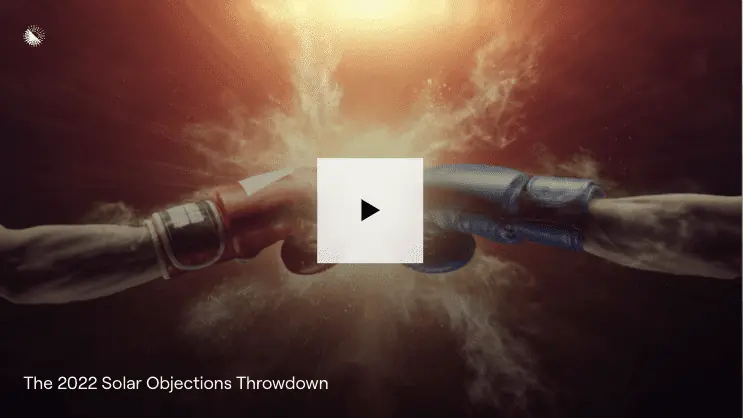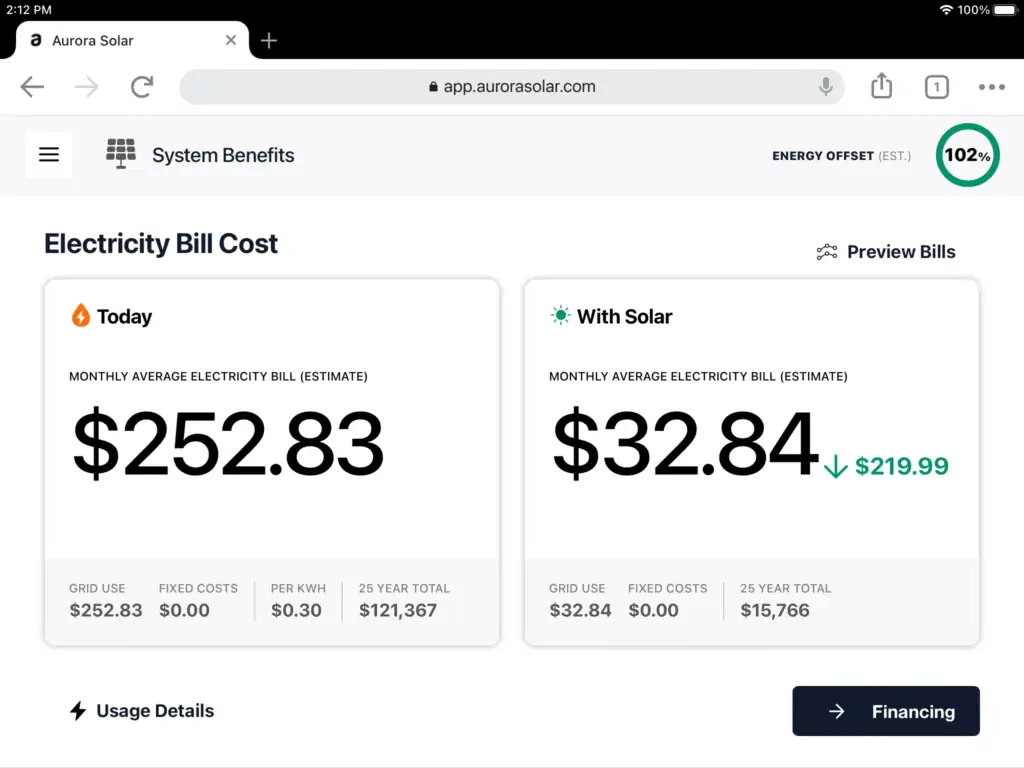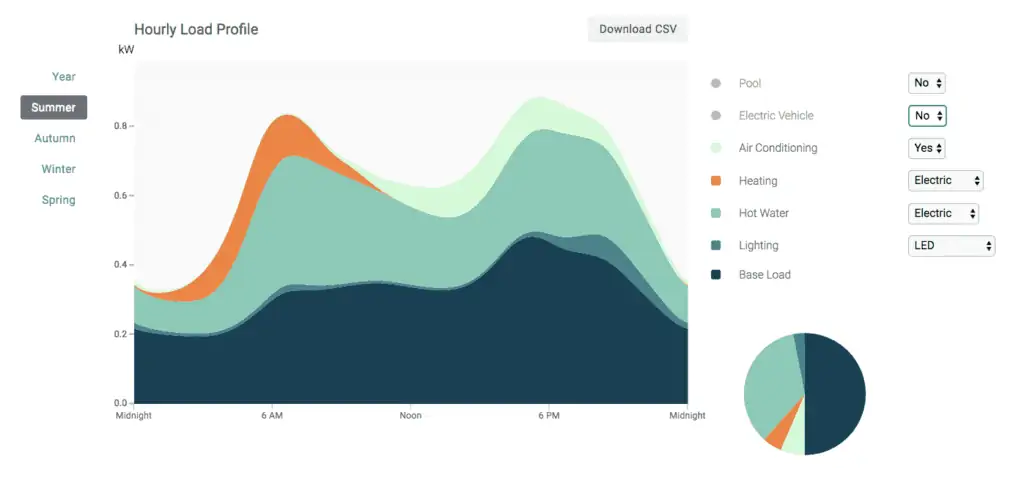Selling solar isn’t easy, but with the right framework, you can make it easier. A good framework can help you effectively address the prospect’s concerns and communicate the value of a solar installation from your company.
The Keys to Selling Solar
Aurora Solar team members Elliot Goldstein and Kenneth Williams recently discussed practical strategies for improving your residential solar sales, based on their personal experiences selling millions of dollars in solar installations for leading U.S. solar companies.
They identify three questions that your sales conversation should answer for every prospective customer:
- Why does solar make sense for them?
- Why is your company the best fit to install solar for them?
- Why should they go solar now?

By building up the potential upsides of going solar, you grab their interest right away while prepping them for the initial cost. It’s crucial to get buy-in on these topics before discussing the cost of the system, which should be the final stage of your conversation.
Price psychology dictates that sticker shock can curb enthusiasm, unless the advantages are well laid-out beforehand. Elliot cautions that, “If they don’t want to get away from their utility yet, you’ll price shock your customer.”
But, if each of these questions is answered well early on, you’re much more likely to win the customer’s business. Here’s how to tackle these topics in your sales pitch.
The Most Important Solar Sales Pitch Question: Why Solar?
The goals for answering this question:
- Educate your prospect on how their current electric use isn’t sustainable
- Mutual, engaging dialogue about your prospect’s situation is critical to compelling them to invest in solar
- Substantial but easy-to-digest data (such as visuals) helps in driving home your message
For the customer that isn’t yet sure if solar is right for them, how do you delve into the value solar offers? One of the best ways is to start with an understanding of the customer’s current challenges with their electric bill.
Kenneth Williams points out, “This is a teaching moment for you to educate your prospect on why their current situation is not sustainable. It’s best if you have their bill present or can provide some visuals for them to see how they’re using energy over the year. Before you can pitch solar as a solution with value, your prospect needs to understand they have little or no control over their current utility bill.”
Solar software like Aurora offers powerful visual tools you can use to explore your prospect’s current energy consumption with them. This can also be a good starting point for asking the customer about their motivations for considering solar and any concerns they have — so you can tailor your conversation to what they care about most.
“If your prospect isn’t talking, you’re not closing the sale.”
Kenneth explains, “If your prospect isn’t talking, you’re not closing the sale. Solar sales is really about having great dialogue and understanding who you are speaking with and their true reasons for buying solar energy for their home.”
Depending on how much information the customer has about their electricity bills, Aurora provides a few different tools for understanding their energy use and spending, including options for uploading interval data if they have it from their utility. If they only have a few recent bills or just know how much they spent in certain months, Aurora’s bill estimator tool can model what their energy consumption likely looks like throughout the rest of the year based on typical usage profiles in their area.

This can help the prospect conceptualize how much they’re spending and provide a starting point for how solar can provide greater control over their energy bills.
Elliot offers this tip, “I love this visual of their kilowatt-hour consumption and monthly cost side by side; it helps me focus their attention on the spikes in their bill.”
In fact, in Sales Mode, you can enter as little as one monthly utility bill (of course, the more you can enter, the better) and you’ll be able to show the homeowner their consumption throughout the year, as well as how much they can expect those bills to increase over the next 25 years. This puts a customer’s potential savings in stark contrast with all that money going to a utility company every month.
“I like to ask them if they’ve tried to reduce their bill in the past and how that’s worked out,” says Elliot. “Many have already tried efficiency upgrades but utility rates have continued to go up as well. As a best practice, I like to pick the highest bill that they have… and calculate what that will be five years from now if the historic rate hikes of about 3-to-5% for most utilities continue.”
You can also build trust by consulting with the customer on any changes they have planned that would impact their energy usage — such as plans to purchase an electric vehicle or a pool — and how solar can help them. Aurora’s Consumption Profile tool lets you explore how their bills may change in the future due to these kinds of changes.

Throughout the process, keep that dialogue going and be sure to ask clarifying questions to make sure you’re really understanding the customer’s priorities, goals, and concerns.
The Second-Most Important Solar Sales Pitch Question: Why Your Company?
The goals for answering this question:
- Substantiate the positive difference and uniqueness in your company and your competitors
- Establish trust by using software to support how you’ve accurately arrived at your numbers
In addition to communicating the value solar can offer to the customer, you also need to answer the question of why they should choose your company.
How do you communicate what makes your company stand out from the pack in a competitive industry where many homeowners are getting several different solar quotes? Ultimately, how do you establish the trust that your company deserves? Let’s look at each question individually:
- Why are you unique? You’ll certainly want to emphasize the products and services that make your company unique. Is your customer satisfaction off the charts? Are you using more efficient panels or offering a great warranty?
- Why should they trust you with the transition? As the salesperson, you play a key role in communicating how your company will ensure that the solar installation — and the resulting savings they receive — lives up to expectations.
Elliot points out, “Using advanced [solar] software can build that trust in why your numbers are accurate. Anyone can make up an estimate that looks good…. but if you can show why your numbers have a solid foundation and why your quote is less likely to change after they sign a contract, that’s one way to leave a lasting impression when your customer is likely to get 3-5 bids.”
Aurora’s Sales Mode gives you an easy way to personalize your proposals, highlighting the things that make your company stand out.
Then, designing in Aurora gives you a number of tools to ensure that your proposed solar design — and the resulting energy production and bill savings — are accurate, and giving the customer a walk-through of some of these tools can help them see firsthand the precision and attention to detail that you’re putting into their proposal.
Some of these features of your design process that you may want to highlight for the customer include:
- Your precise 3D model of their house that ensures panels will fit as anticipated and that the design will look the way they expect it to
- Aurora’s accurate, NREL-validated shading analysis, including the visually striking irradiance map of their home that can help communicate the best places for panels
- The ability to configure setbacks based on the requirements of their local jurisdiction, which ensure you won’t have to redo their design because of setback violations
- The precision of Aurora’s energy production and bill estimates

The Third-Most Important Solar Sales Pitch Question: Why Now?
The goals for answering this question:
- Understanding your potential customer’s initiatives plays a critical role in covering the question “Why now?”
- External factors such as rising utility rates, tax breaks, and limited-time opportunities are great incentives for urgency
- Trust in the quality of your company’s product, and don’t overcompensate to close a deal
A final question you need to answer for the customer is why it makes sense to go solar now. To do this, you need to build a sense of urgency. This could be rooted in their own plans and goals or in external factors.
Kenneth advises, “This is where a lot of what you learned from the dialogue with the customer is going to come in handy. Depending on their goals for going solar, they may have their own factors that create a natural sense of urgency so it can help to put things in those terms. Is summer coming up and they’re really trying to avoid those high summer spiking electricity bills? Are they in the process of buying an EV?”
Elliot adds, “You can also use external factors, like utility rate increases, to underscore why going solar now may be better than waiting.”
Educating your customer on the value of getting grandfathered into a net metering plan can also help, particularly if they’re concerned about waiting for technology to improve. If a robust net metering rate is available to your customer, getting access to that now may result in better financial return over the life of their system than waiting, particularly if the utility is considering future rate changes that will reduce the value of solar.
Limited-time promotions and discounts can also build urgency, but Elliot cautions that you should use them wisely. “I see many reps start using these as crutches and end up giving away their commission and the company’s profit. If you’ve built perceived value in your brand, most homeowners are willing to pay more to get quality. I recommend only using discounts to push your sale to close quickly at the end once your customer is bought into you and your company.”

Wrapping it Up
For more detailed insights on this framework, and many more tips for improving your sales of residential solar, check out The Solar Sales Playbook for Proposals that Close.
If you have specific questions about improving your sales processes, reach out to schedule a customized, no-pressure demo.



